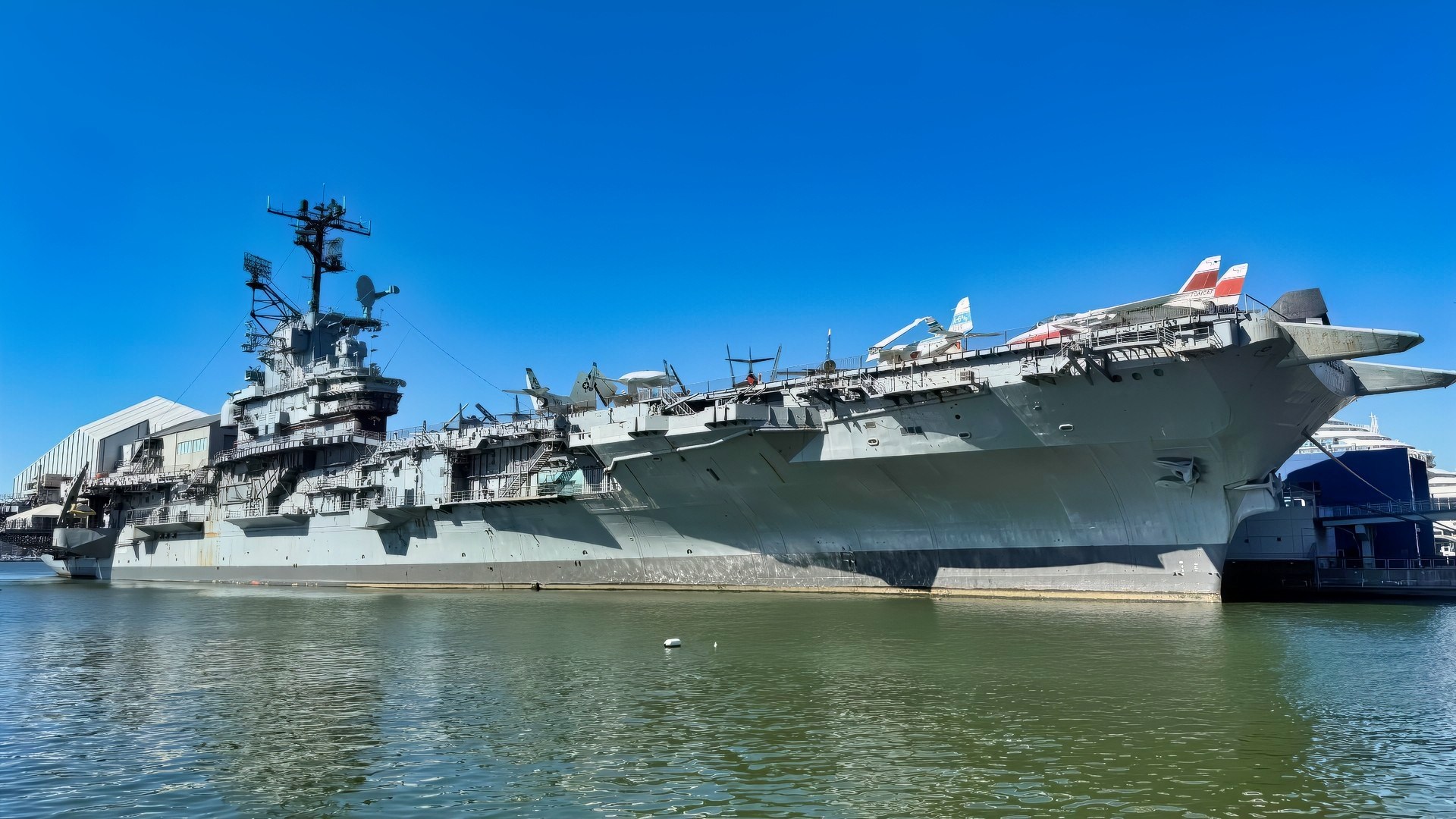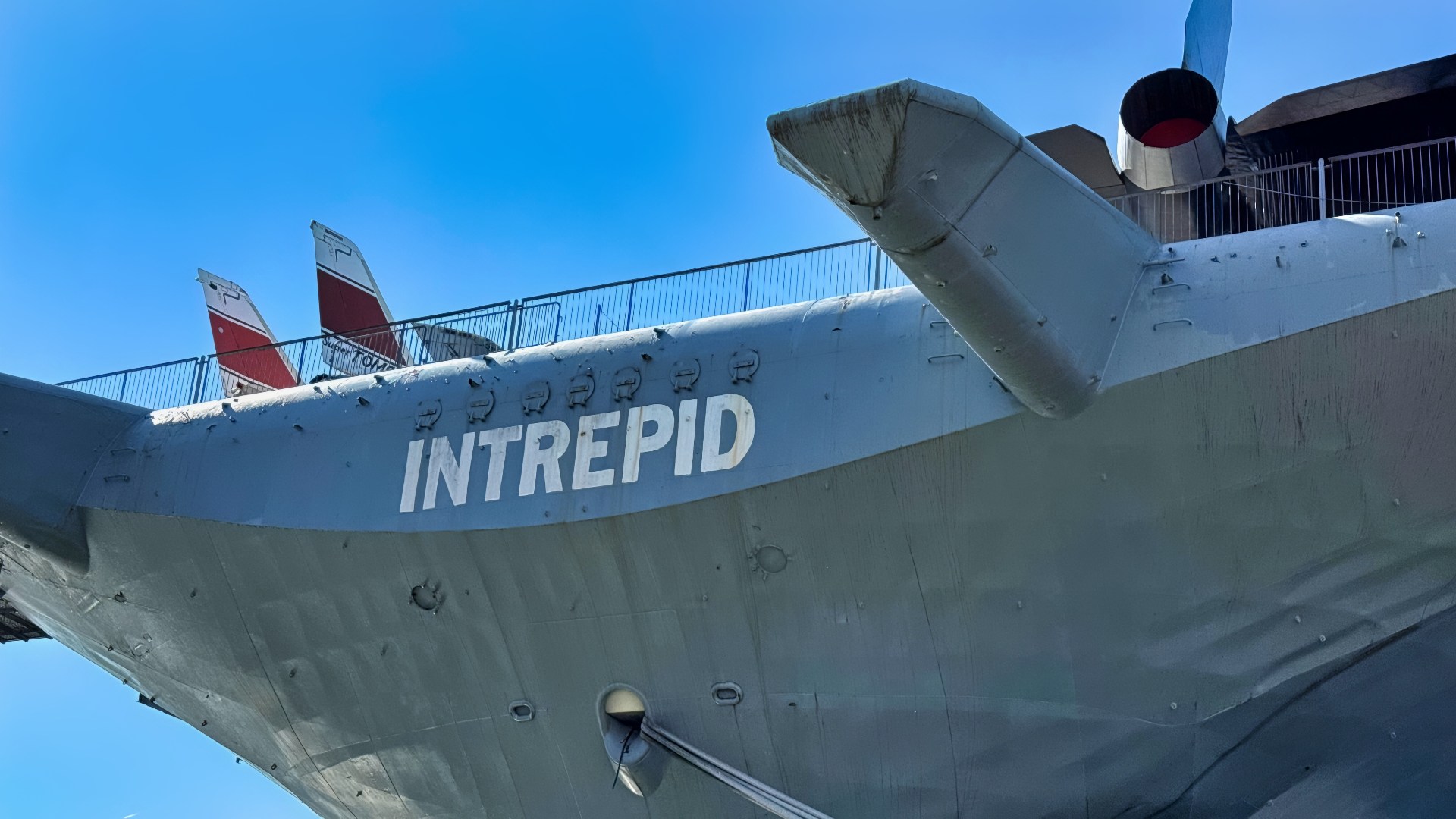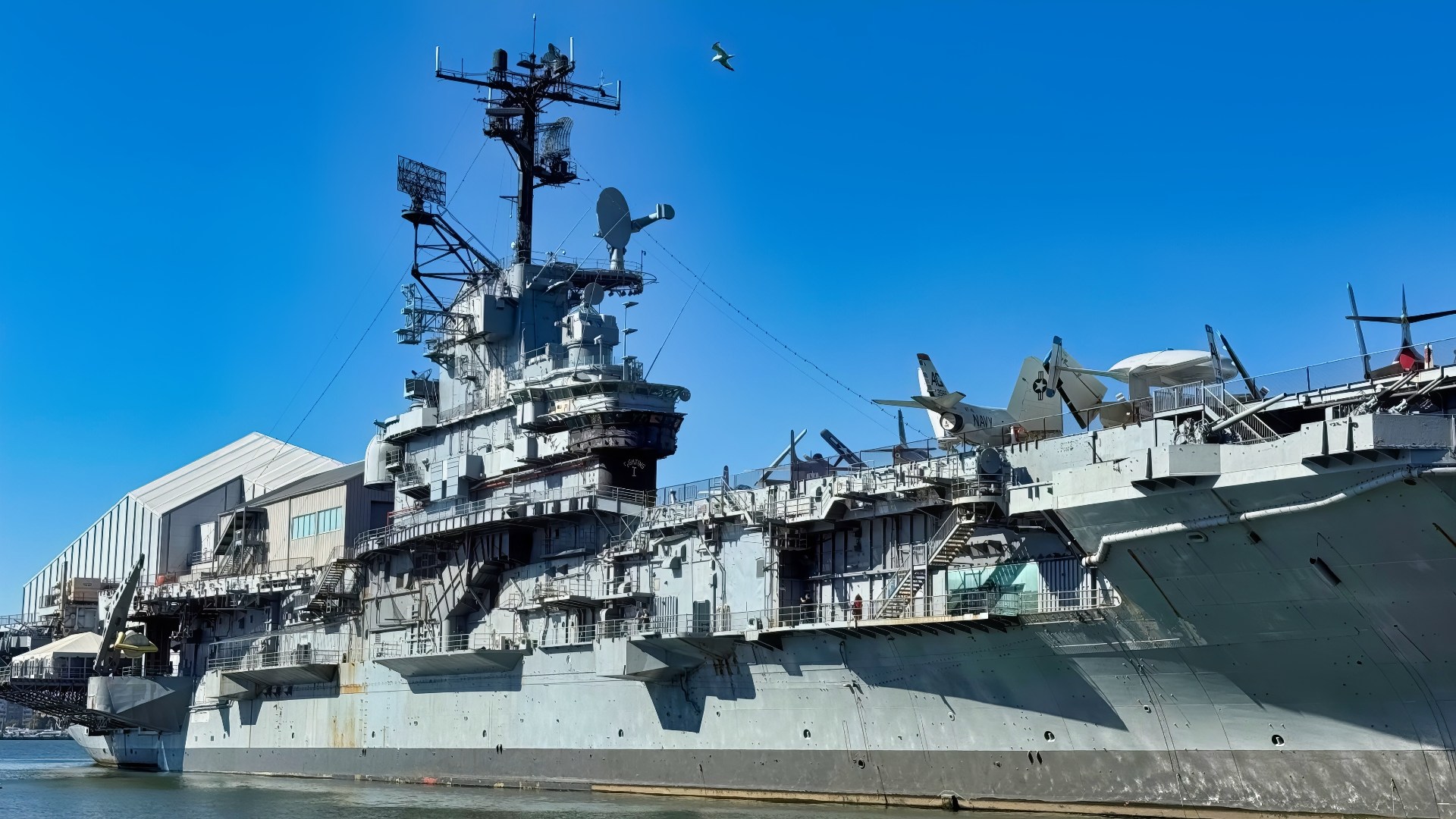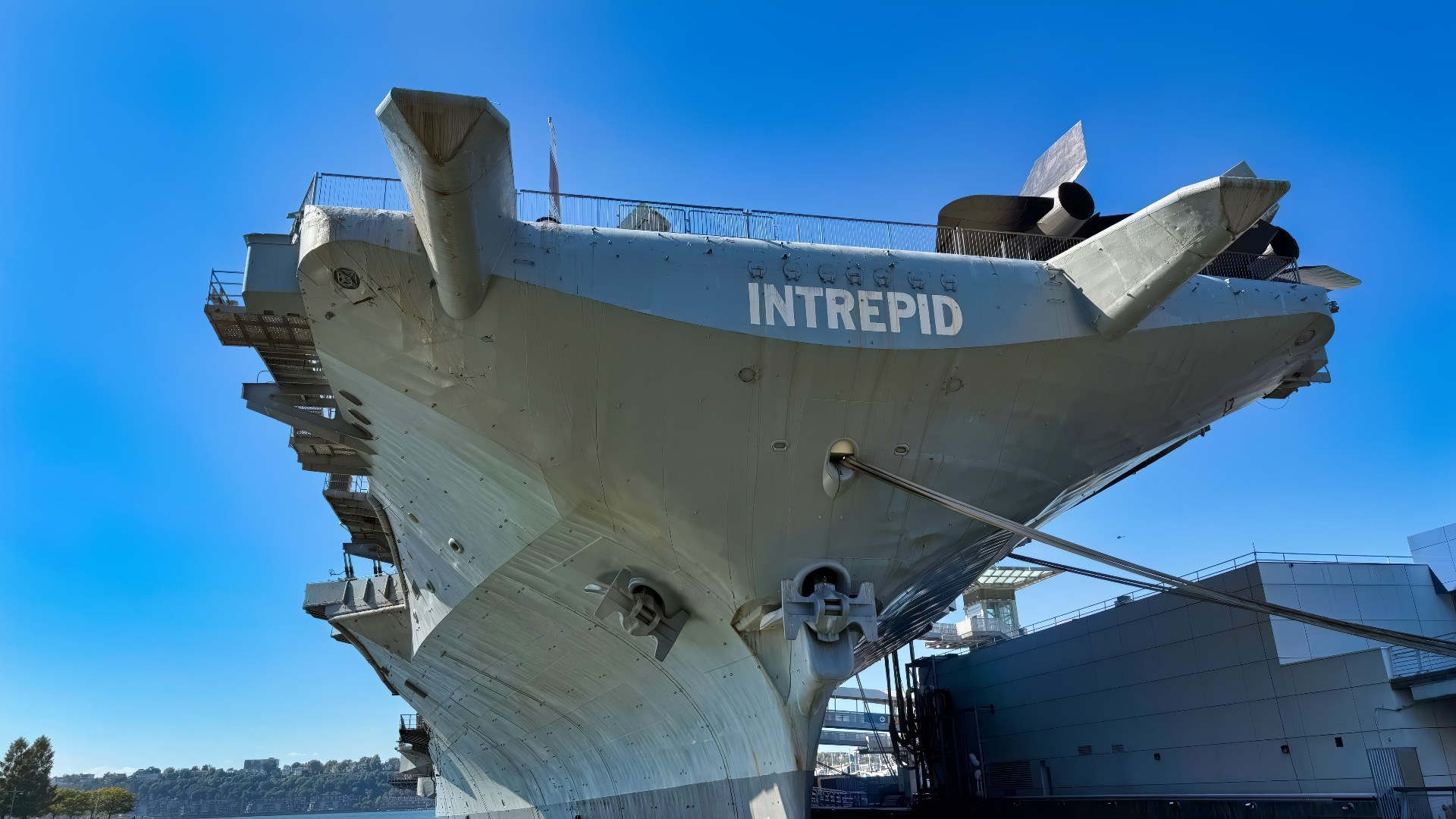Article Summary – Essex-Class Carriers: The WWII Workhorses That Fought Into Vietnam
-The U.S. Navy’s Essex-class carriers—24 ships built from 1941–46—were the backbone of American naval air power from mid-WWII through Vietnam.

Essex-Class USS Intrepid Aircraft Carrier. Image Credit: National Security Journal.

Essex-Class Carrier USS Intrepid NSJ Photo.
-Larger and tougher than predecessors, they combined speed, range, and survivability, shrugging off severe damage (notably USS Franklin) while enabling decisive Pacific campaigns.
-None were lost in WWII. Postwar, extensive modernizations—such as angled decks, steam catapults, JBDs, and stronger elevators—adapted them for jets and helicopters, keeping them relevant for Korea, Vietnam, and even NASA recovery missions.
-With up to 90 aircraft and formidable AA batteries, the class defined carrier warfare for three decades.
-Four museum ships survive: Yorktown, Hornet, Lexington, and Intrepid.
-Bonus: National Security Journal recently visited the Essex-class USS Intrepid and includes photos from that visit.
Essex-class Aircraft: The Backbone From WWII To Vietnam
The Essex-class was a highly successful, large class of 24 U.S. Navy aircraft carriers, serving as the backbone of the US Navy’s fleet from mid-1943 through the Vietnam War before being superseded by supercarriers.
None were lost to enemy action during World War II, though some were heavily damaged, especially by kamikazes late in the war. Four remain in existence today as museum ships: the Yorktown, the Hornet, the Lexington, and the Intrepid.
The Essex class was designed to surpass previous carriers, offering a good balance of speed, armor, and striking power. It was freed from the restrictions of the Washington Naval Treaty after Japan rejected it, with the beginning of the Naval Expansion Act of 1938.
The class included both “short-hull” and “long-hull” versions, with 24 ships completed from an initial order of 32.
The Essex class was crucial to the U.S. victory in the Pacific theater during World War II, operating in major battles and surviving kamikaze attacks. The Essex carriers swept the Japanese navy from the Pacific, giving the US the massive firepower to bring to bear an unbeatable force anywhere in the Pacific, something the Japanese could not hope to compete with.
After the war, the carriers underwent multiple modernizations and upgrades to handle the new jet aircraft and helicopters of the jet age, including angled flight decks. They continued to form a significant part of U.S. naval air power into the Korean and Vietnam Wars before gradually being replaced by larger supercarriers.
Essex Carrier Design
The Essex-class carriers were over sixty feet longer (888 feet), nearly ten feet wider (147.5 feet), and more than a third heavier (36,960 tons full combat load) than Yorktown-class carriers.
A longer, more expansive flight deck and a deck-edge elevator (which had proven successful in the one-off USS Wasp) facilitated more efficient aviation operations, enhancing the ship’s offensive and defensive air power.

Essex USS Intrepid Carrier. Image Credit: National Security Journal.
The Essex carriers had better armor protection than their predecessors, improved facilities for handling ammunition, increased fuel capacity, and more effective damage control equipment.
Yet, these ships were also designed to limit weight and the complexity of construction, for instance, incorporating extensive use of flat and straight metal pieces, and of Special Treatment Steel (STS), a nickel-chrome steel alloy that provided the same protective qualities as Class B armor plate, but which was fully structural.
The Essex class was powered by eight Babcock & Wilcox boilers, producing 150,000 shaft horsepower (110,000 kW), and propelled by Westinghouse geared turbines with four screw propellers. It had a top speed of 33 knots (38.6 mph).
They had a range of 20,000 nautical miles.
Essex-class Carriers Armament
The carriers mounted twelve 5-inch (130 mm) 38 caliber guns (in 4 enclosed twin mounts located near the island on the starboard side and four single open mounts located on the port side forward and port side aft).
These guns had a maximum range of seven miles and a rate of fire of fifteen rounds per minute. The 5-inch guns could fire VT shells, known as proximity-fuzed shells, that would detonate when they came within range of an enemy aircraft. The 5-inch guns could also aim into the water, creating waterspouts which could bring down low-flying aircraft such as torpedo planes.
There were also seventeen quadruple Bofors 40 mm anti-aircraft guns and 65 single Oerlikon 20 mm cannon. The Bofors 40 mm guns were a significant improvement over the 1.1 in/75 caliber guns mounted in the earlier Lexington and Yorktown classes. And were controlled by Mark 51 optical directors with integrated gyro gun-sight lead-angle calculators.
The Essex-class aircraft carriers carried 90 aircraft, 36 F6F Hellcat fighters, 36 Douglas SBD Dauntless dive bombers, which were later replaced by the inferior Curtiss SB2C Helldiver, and 18 of the Grumman TBF Avenger torpedo bombers.
War Service In the Pacific Theater
By the end of 1943, the contribution of the Essex-class aircraft carriers, together with the Independence-class carriers, dominated the seas and skies in America’s favor during the Pacific War, starting with the recapture of the Gilbert Islands.
The carriers ensured air superiority by the US Navy, and that turned out to be the beginning of the end of Japanese supremacy in the Pacific. The deployment of the Essex carriers was a crucial factor in Japan’s defeat.
Japanese losses in carriers and, more importantly, the trained aircrews earlier in 1942 were never adequately replaced. With the massive influx of American carriers and highly trained aircrews, the US dominated the Pacific naval war.
The Essex-class carriers conducted air raids on Japanese-occupied islands, in the reconquest of these islands by protecting the invasion forces and in the transportation of hundreds of fighter aircraft and thousands of troops.
From late 1944, the Essex-class aircraft carriers were primarily used to attack Japan itself, a role that was later taken over by the B-29 long-range bombers.
On October 30, 1944, during the Battle of Leyte Gulf, the first recorded use of kamikazes by the Japanese was noted, as three kamikazes attacked the USS Franklin. One hit the flight deck with such force that it penetrated to the hangar deck, igniting a massive fire that killed 56 crewmen and injured 60 others.
After repairs, the Franklin returned to action and was later hit by Japanese high altitude bombers in March of 1945, with her flight deck loaded with 30 aircraft warming up and fully combat loaded. That killed 796 crewmen, bringing the total of USS Franklin fatalities during the war to nearly 1,000, which was second only to the USS Arizona, which was sunk at Pearl Harbor.
The Korean And Vietnam Wars
After World War II had ended, the Essex-class carriers were upgraded to handle the larger and heavier jet aircraft. Among these modifications were jet-blast deflectors (JBDs), greater aviation fuel capacity, stronger decks, and elevators.
Also included were British innovations such as an optical landing system, steam catapults, and, ultimately, an angled flight deck.
Twenty-two Essex-class ships saw extensive use during the Korean War years, with 11 being deployed in combat. The Franklin mentioned above and the Bunker Hill, which also suffered massive damage by kamikazes, were repaired but never recommissioned.
Thirteen of the Essex carriers were used in action during the Vietnam War. Several Essex-class carriers saw use in the NASA space program as recovery platforms for space aircraft returning from lunar missions.
They were all retired by the late 1970s, except for the Lexington, which continued to serve as a training carrier until 1991. Four of the Essex carriers, the Yorktown, the Lexington, the Hornet, and the Intrepid, serve as museum ships.
We were there a month ago, and highly recommend seeing the Essex-class carrier USS Intrepid.
About the Author: Steve Balestrieri
Steve Balestrieri is a National Security Columnist. He served as a US Army Special Forces NCO and Warrant Officer. In addition to writing on defense, he covers the NFL for PatsFans.com and is a member of the Pro Football Writers of America (PFWA). His work was regularly featured in many military publications.
More Military
Thrust Vectoring 101: The Jet Trick That Bends Physics—and Dogfights
The Big F-20 Tigershark Fighter Program Mistake Still Stings
2025: The Year America and Venezuela Go to War?
Forget China’s J-50: U.S. 6th-Generation NGAD Fighters Flew Back in 2019










